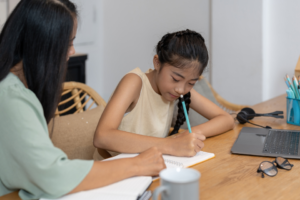
Elicit & Listen: How to Communicate Effectively with Young People
 Kids and adolescents are all to accustomed to being “shushed,” being told to wait, and, often, feeling that they must stifle their immediate thoughts and feelings. It’s no wonder, then, that many aren’t exactly in a hurry to share, hence the famous “how was school?” question, which is invariably answered with an uninspired “fine.” There are, however, some very effective communication strategies for making young people feel comfortable sharing and helping them begin to establish strong skills of communication and listening.
Kids and adolescents are all to accustomed to being “shushed,” being told to wait, and, often, feeling that they must stifle their immediate thoughts and feelings. It’s no wonder, then, that many aren’t exactly in a hurry to share, hence the famous “how was school?” question, which is invariably answered with an uninspired “fine.” There are, however, some very effective communication strategies for making young people feel comfortable sharing and helping them begin to establish strong skills of communication and listening.
Empathic Responses
Sounds easy enough, right? But the truth is that often, our responses are geared less toward listening and empathy and more toward wanting to give advice, admonish, or speak our piece. Responding empathically, and thus validating another person’s concerns, is a skill that can work exceptionally well with children and adolescents. Our words, of course, are important, but even our body language and mood can be important factors in how we come across to another person. A response such as a cross-armed “well you should have done x, y, or z” does not provide empathy, but rather gives an instruction, as well as an implication that the person did not do something correctly. This kind of response will most likely shut the conversation down. A more empathic response would be simply stating “that sounds like it was difficult for you.” This type of reaction opens up a world of opportunity for the other person to feel safe enough to continue to share. Closed-ended responses like “well what you did was wrong” can quickly bring on silence. With empathy, we strive to understand another’s situation, not to judge it or make recommendations. When we are dealing with emotionally vulnerable young people, responding empathically is vital.
Furthering
It can be easy to sometimes feel relieved when someone is finished complaining or venting. But by shutting down the conversation, we lose the ability to “dig deeper” into a person’s problems or concerns. By furthering the conversation, on the other hand, we may gain more insight into a person’s situation than only what appears on the surface. You might further a conversation with a young person by asking something like “then what happened?” or “can you tell me more about that?” Questions phrased in this way allow for deeper responses. From these answers, we may end up with a much more complete picture of a person’s situation. Particularly with kids in emotional or family turmoil, we have to be cognizant of furthering, so that we can obtain all the information we need to best intervene and offer solutions to problems.
Open-Ended Questions
The infamous “how was school?” question is so close-ended, it basically begs to be answered with a non-response like “good” or “fine.” To “open up” this question, we might phrase it differently: “that was a long day at school for you. How are you feeling?” or “you seem tired. What’s up?” These more open-ended responses can lead to more in-depth answers. Keeping the question open-ended allows for a person to consider the response, and insert more information into it. Closed-ended questions, by contrast, often lead to vague and uninformative answers.
Ask-Elicit-Ask
Asking good questions will elicit the good answers is a simple way to look at this technique. Much in the vein of “garbage in, garbage out,” asking flimsy questions will typically result in flimsy responses. “How’s it going?” “Good” is a classic example. By eliciting information, however, we create conversation rather than simplistic responses. Consider a situation in which a child has gotten in trouble in class and you need to find out his version of what happened. Asking a question like “why did you get in trouble?” could potentially lead to a vague answer like “I don’t know” or “the teacher’s mean.” “Why” questions don’t leave a lot of room for reflection, however, “how” questions can be much more effective. For example, “how do you feel about getting detention?” may inspire a more heartfelt and informative answer. From that answer (perhaps, “it ticked me off”), you can then respond empathically, ask another open-ended question, and thus further the conversation.
Written by Phil Lane
Contact us today to learn more about how our tutors can help your child this fall!
Tag:communication



